Introducción
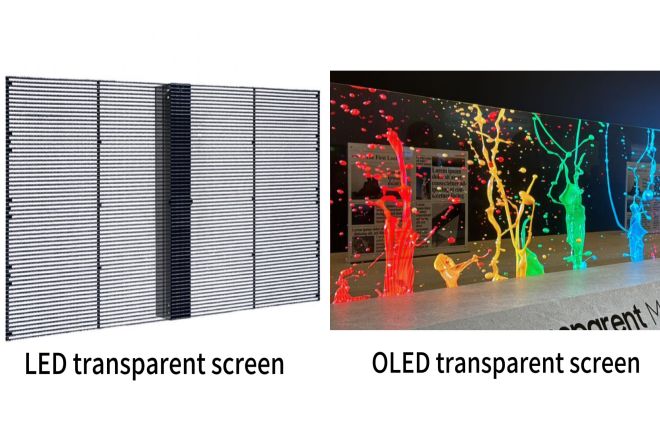
Con el continuo desarrollo de la ciencia y la tecnología, la tecnología de pantallas transparentes se ha convertido gradualmente en un punto destacado en el campo de las pantallas modernas. Con su transparencia única y su efecto de visualización de alta definición, las pantallas transparentes han aportado una nueva experiencia visual a muchos campos, como la exhibición comercial, el transporte público, el hogar inteligente, etc.
Entre las muchas tecnologías de visualización transparente, Pantallas LED transparentes y las pantallas transparentes OLED han atraído mucha atención en el mercado con sus respectivas ventajas.
1. Introducción a la pantalla LED transparente
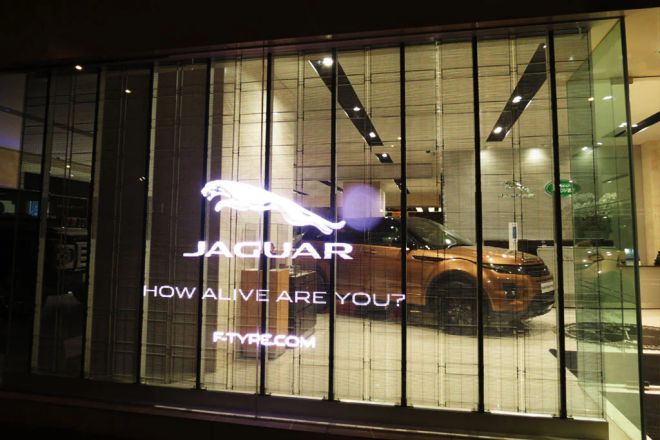
La pantalla LED transparente, también conocida como pantalla LED transparente, es una innovación importante en la tecnología de visualización moderna. El núcleo de esta pantalla reside en su estructura única. Utiliza una gran cantidad de microesferas de lámpara LED como unidades de visualización e instala inteligentemente estas microesferas de lámpara sobre un sustrato transparente. Estos sustratos suelen estar hechos de vidrio o plástico de alta resistencia, lo que garantiza la transparencia general de la pantalla y la estabilidad de la estructura.
En el estado no luminoso, el sustrato transparente de la pantalla LED permite que la luz penetre libremente, lo que hace que la escena detrás de la pantalla sea claramente visible sin ninguna obstrucción. Esta característica hace que la pantalla LED transparente tenga un valor de aplicación extremadamente alto en escenas como exhibiciones comerciales, decoración de ventanas y muros cortina de vidrio arquitectónicos porque puede proporcionar una gran cantidad de información visual sin interferir con la línea de visión.
Cuando se enciende la pantalla LED transparente, decenas de miles de microesferas de lámpara LED se iluminarán según el patrón preestablecido o el contenido del video, formando un efecto de visualización claro y brillante. Estas microesferas de lámpara LED tienen un brillo y una expresión de color excelentes y pueden presentar imágenes brillantes y vívidas para atraer la atención de las personas.
Las características de la pantalla LED transparente incluyen principalmente:
Alta transparencia: Cuando no se muestra la imagen, la pantalla es casi completamente transparente y puede integrarse bien con el entorno circundante.
Alto brillo y colores brillantes: Las perlas de la lámpara LED pueden emitir luz de alto brillo, los colores son brillantes y completos y el efecto de visualización es excepcional.
Fuerte plasticidad: Las pantallas LED transparentes se pueden fabricar en varias formas y tamaños para satisfacer diferentes necesidades de visualización.
Ahorro de energía y protección del medio ambiente: El LED tiene una alta eficiencia luminosa, bajo consumo de energía y baja generación de calor, lo que favorece el ahorro de energía y la protección del medio ambiente.
Larga vida: Las lámparas LED tienen una larga vida útil, alta confiabilidad y bajo costo de mantenimiento.
2. Introducción a la pantalla transparente OLED
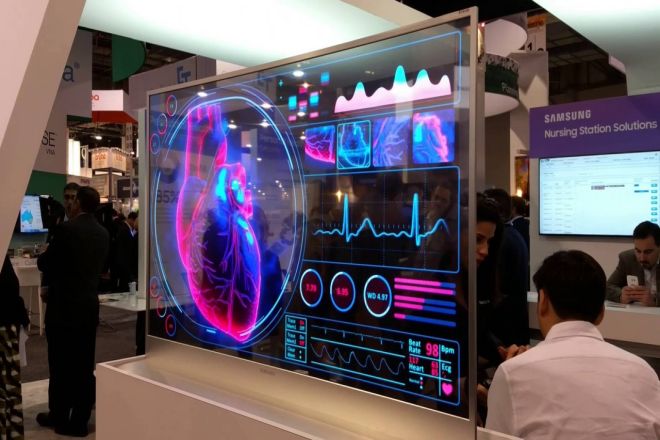
Pantalla transparente OLED, el nombre puede sonar un poco complicado, pero de hecho el principio detrás de ella es relativamente intuitivo y fácil de entender. En primer lugar, debemos entender OLED, es decir, diodo orgánico emisor de luz (Organic Light-Emitting Diode). Se trata de una tecnología de visualización avanzada, y su núcleo radica en la característica de "autoluminiscencia".
Imaginemos que los televisores LCD tradicionales o los monitores de ordenador necesitan una luz de fondo para iluminar los píxeles de la pantalla, pero el OLED es diferente. Cada uno de sus píxeles tiene la capacidad de autoluminiscencia.
Esto significa que cuando queremos mostrar una imagen o texto en la pantalla, sólo necesitamos activar los píxeles correspondientes y estos emitirán luz por sí solos sin necesidad de fuentes de luz adicionales.
Ahora bien, cuando combinamos la tecnología OLED con pantallas transparentes, obtenemos pantallas OLED transparentes. Lo especial de esta pantalla es que su sustrato es transparente y los píxeles OLED están distribuidos uniformemente sobre este sustrato transparente. Por lo tanto, cuando los píxeles OLED no emiten luz, toda la pantalla parece transparente y podemos ver claramente la escena detrás de la pantalla.
Las principales características de las pantallas transparentes OLED incluyen:
Autoluminiscencia: Los píxeles OLED pueden emitir luz de forma independiente sin luz de fondo, lo que hace que la pantalla sea más delgada y transparente.
Alto contraste y ángulo de visión: El contraste de las pantallas transparentes OLED es extremadamente alto, lo que permite presentar negros más profundos y colores más brillantes. Al mismo tiempo, debido a que la capa emisora de luz OLED es plana y la luz se distribuye de manera uniforme, la pantalla tiene un ángulo de visión más amplio.
Respuesta rápida: El tiempo de respuesta de una pantalla OLED transparente es extremadamente corto y puede responder a los cambios de imagen rápidamente para evitar manchas.
Alta saturación de color: La saturación de color de una pantalla transparente OLED es tan alta como 98%, lo que puede presentar imágenes más realistas y vívidas.
Flexible y flexible: Los materiales OLED son flexibles y pueden convertirse en pantallas plegables y flexibles, lo que brinda más posibilidades para la tecnología de visualización futura.
3. Comparación de parámetros de rendimiento
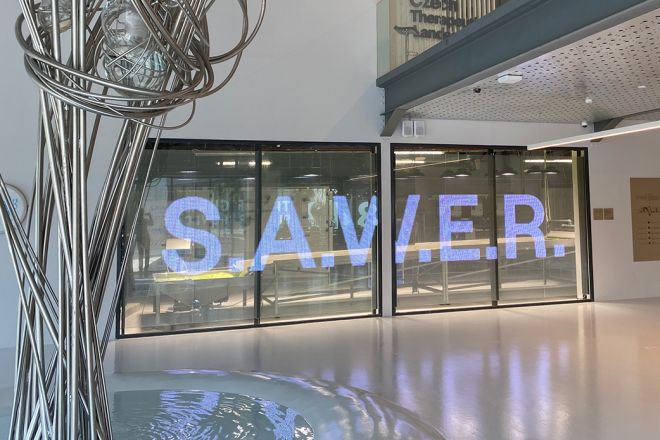
1) Brillo y contraste
- Pantalla LED transparente:
La pantalla LED transparente suele tener un alto rendimiento de brillo, y el brillo básico puede alcanzar 4000-5000cd/㎡. Esto se debe a que las perlas de la lámpara LED están expuestas directamente al exterior sin ninguna obstrucción, por lo que el brillo es mayor.
Sin embargo, con un brillo alto, el contraste de una pantalla LED transparente puede verse afectado hasta cierto punto porque el fondo con alto brillo puede reducir el contraste entre la imagen y el fondo.
- Pantalla transparente OLED:
El brillo de una pantalla OLED transparente suele estar entre 1000 y 1500 nits, ligeramente inferior al de una pantalla LED transparente. Sin embargo, debido a sus características de autoluminiscencia, el contraste de una pantalla OLED transparente es extremadamente alto y, en teoría, puede llegar al infinito.
Esto hace que la imagen aparezca en blanco y negro y con colores más vivos cuando se presenta en la pantalla transparente OLED.
2) Ángulo de visión y color
- Pantalla LED transparente:
El ángulo de visión de la pantalla LED transparente es generalmente de alrededor de 140° horizontalmente y 140° verticalmente. Dentro de este rango, el rendimiento del color es relativamente estable. Sin embargo, cuando el ángulo de visión se desvía de este rango, el color puede distorsionarse.
- Pantalla transparente OLED:
El ángulo de visión de la pantalla transparente OLED es más amplio porque la capa emisora de luz OLED es plana y la luz se distribuye de manera uniforme, por lo que el rendimiento del color se mantiene constante en casi cualquier ángulo. Además, la pantalla transparente OLED tiene una ventaja significativa en la saturación del color y puede presentar imágenes más vívidas y realistas.
3) Tiempo de respuesta
- Pantalla LED transparente:
El tiempo de respuesta de la pantalla LED transparente suele ser inferior a 3 ms, lo que significa que al mostrar imágenes dinámicas, la pantalla LED transparente puede responder a los cambios de imagen más rápido y evitar manchas.
- Pantalla transparente OLED:
El tiempo de respuesta de la pantalla OLED transparente es incluso mejor, generalmente por debajo de 1 ms. Esto permite que la pantalla OLED transparente proporcione efectos visuales más fluidos y coherentes al mostrar imágenes dinámicas de alta velocidad.
4) Consumo de energía y vida útil
- Pantalla LED transparente:
El consumo de energía de la pantalla LED transparente es relativamente bajo, gracias a las eficientes características de emisión de luz de las perlas de la lámpara LED. Sin embargo, el nivel de consumo de energía específico depende de factores como el brillo y el tamaño de la pantalla. En términos de vida útil, las pantallas LED transparentes suelen tener una vida útil más larga y pueden funcionar de manera estable durante decenas de miles de horas.
- Pantalla transparente OLED:
El consumo de energía de las pantallas transparentes OLED también es relativamente bajo, pero debido a sus características de autoluminiscencia, cada píxel necesita ser alimentado independientemente, por lo que el consumo de energía general puede ser ligeramente mayor que el de las pantallas transparentes LED del mismo tamaño.
Sin embargo, la vida útil de las pantallas transparentes OLED también es muy larga y pueden funcionar de manera estable durante más de decenas de miles de horas. En términos de ahorro de energía y costos operativos a largo plazo, ambas tienen un buen rendimiento.
4. Comparación de escenarios de aplicación
1) Exhibición comercial
1.1) Pantalla LED transparente:
Anuncio comercial: Las pantallas LED transparentes tienen ventajas significativas en el campo de la publicidad comercial debido a su alto brillo, alto contraste y efectos de visualización claros y realistas. Pueden atraer la atención de los clientes y aumentar la tasa de clics y la tasa de conversión de los anuncios.
Visualización de la ventana: La transparencia de las pantallas LED permite a los comerciantes reproducir anuncios o información de productos en la pantalla sin afectar la visualización de las mercancías en la ventana, atrayendo aún más la atención de los clientes.
1.2) Pantalla OLED transparente:
- Exhibición comercial de alta gama: Las pantallas OLED transparentes tienen un valor único en las pantallas comerciales de alta gama por su alta transparencia, alto contraste y expresión de colores brillantes. Pueden crear una experiencia visual única para las marcas y los productos, y mejorar la imagen y el reconocimiento de la marca.
2) Transporte público
2.1) Pantalla LED transparente:
- Metro, autobús: Las pantallas LED transparentes se utilizan ampliamente en el transporte público, como el metro y los autobuses. Por ejemplo, en los vagones del metro y en las plataformas de los autobuses, las pantallas LED transparentes pueden mostrar información sobre la llegada del vehículo, anuncios y otros contenidos en tiempo real, lo que proporciona servicios de información convenientes para los pasajeros.
2.2) Pantalla OLED transparente:
Sistema de visualización en el vehículo:
Las pantallas OLED transparentes tienen aplicaciones potenciales en los sistemas de visualización de los vehículos. Por ejemplo, se pueden utilizar como parte de la ventana para ofrecer navegación, entretenimiento y otra información sin afectar la visión de los pasajeros del paisaje exterior del vehículo.
Además, las pantallas transparentes OLED también se pueden utilizar en las ventanas del metro para mostrar información básica, como mapas de rutas de funcionamiento del metro y distritos comerciales circundantes en tiempo real.
3) Casa y edificio inteligente
3.1) Pantalla LED transparente:
Casa inteligente: Las pantallas LED transparentes se pueden utilizar en dispositivos domésticos inteligentes como refrigeradores, espejos, etc. Pueden mostrar información como el clima, la hora y la seguridad del hogar, mejorando la comodidad y la inteligencia de la vida hogareña.
Edificio inteligente: Las pantallas LED transparentes se pueden utilizar en áreas públicas de edificios inteligentes, como vestíbulos, pasillos, etc. Se pueden utilizar como medio para la divulgación de información para mostrar información de guía, notificaciones de eventos, etc., dentro del edificio.
3.2) Pantalla OLED transparente:
- Edificios de ciencia y tecnología del futuro:
La pantalla OLED transparente desempeña un papel fundamental en la creación de futuros edificios de ciencia y tecnología. Se puede utilizar como parte de la fachada del edificio para añadir un ambiente más artístico y un toque de moda a la ciudad mostrando obras de arte o anuncios dinámicos.
Además, las pantallas transparentes OLED también se pueden utilizar en el espacio interior del edificio, como particiones transparentes, pasamanos de escaleras y otras ubicaciones, para lograr el efecto de mostrar información y separar espacios.
5. Costos y perspectivas de mercado
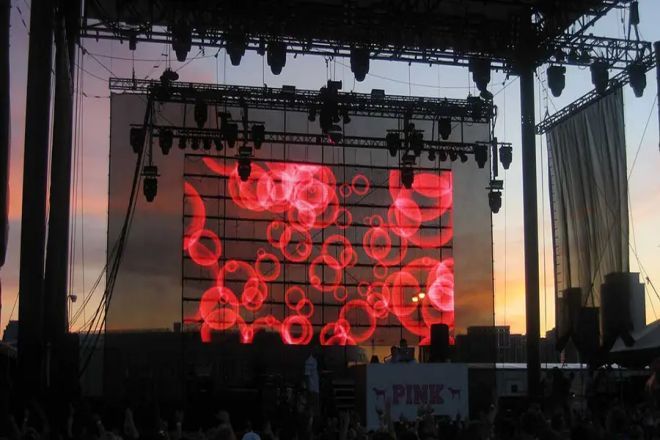
1) Análisis de costos
1.1) Coste de fabricación
- Pantalla LED transparente:
El costo de fabricación de las pantallas LED transparentes es relativamente bajo, debido principalmente al proceso de producción maduro de las perlas de las lámparas LED y al bajo costo del material. Además, el sustrato de las pantallas LED transparentes generalmente utiliza materiales de bajo costo, como vidrio o plástico, lo que reduce aún más el costo de fabricación.
Sin embargo, en escenarios de aplicaciones de alta gama, como pantallas comerciales a gran escala y aplicaciones arquitectónicas de alta gama, el costo de una pantalla LED transparente puede aumentar significativamente debido a la necesidad de mayor resolución, brillo y personalización.
- Pantalla transparente OLED:
El coste de fabricación de una pantalla OLED transparente es relativamente alto, lo que se debe principalmente al alto coste de los materiales OLED y a la complejidad del proceso de producción. La pantalla OLED transparente requiere materiales de sustrato especiales y tecnología de embalaje para garantizar su transparencia y estabilidad.
Además, la densidad de píxeles y la resolución de las pantallas OLED transparentes suelen ser mayores, lo que también aumenta el coste de fabricación. Sin embargo, con el avance continuo de la tecnología y la aparición de economías de escala, se espera que el coste de fabricación de las pantallas OLED transparentes disminuya gradualmente.
1.2) Rentabilidad
En escenarios de aplicación de gama baja y media, como vallas publicitarias de transporte público, pequeñas pantallas comerciales, etc., las pantallas LED transparentes suelen tener una mejor relación costo-beneficio debido a sus menores costos de fabricación y su mayor relación costo-rendimiento.
En escenarios de aplicación de alta gama, como pantallas comerciales de alta gama, exhibiciones de ciencia y tecnología, etc., las pantallas transparentes OLED pueden proporcionar un mayor nivel de experiencia visual debido a sus efectos de visualización únicos y ventajas de diseño, por lo que tienen una mejor rentabilidad.
1.3) Tendencia de cambio de costos
Con el avance de la tecnología y la intensificación de la competencia en el mercado, se espera que los costos de fabricación tanto de las pantallas transparentes LED como de las pantallas transparentes OLED disminuyan gradualmente. Sin embargo, debido a la particularidad de las pantallas transparentes OLED en cuanto a tecnología y materiales, el alcance de su reducción de costos puede ser relativamente pequeño.
2) Perspectivas del mercado
2.1) Tamaño del mercado y tendencia de crecimiento
El mercado actual de pantallas transparentes se encuentra en una etapa de rápido crecimiento, principalmente debido a la creciente demanda de los consumidores de una experiencia visual de alta calidad y la expansión continua de las aplicaciones de pantallas transparentes en varios campos.
Se espera que en los próximos años, el mercado de pantallas transparentes continúe manteniendo una tendencia de crecimiento de alta velocidad y el tamaño del mercado se expandirá aún más.
2.2) Patrón de competencia y tendencia de desarrollo
- Pantalla LED transparente:
Debido a su menor costo y mayor relación costo-beneficio, la pantalla LED transparente tiene una mayor ventaja competitiva en los mercados de gama baja y media. En el futuro, las pantallas LED transparentes seguirán manteniendo su posición de liderazgo en el transporte público, la exhibición comercial y otros campos, y podrían expandirse aún más a los hogares inteligentes y la arquitectura, entre otros campos.
- Pantalla transparente OLED:
La pantalla transparente OLED tiene una ventaja competitiva única en el mercado de alta gama, y su efecto de visualización único y sus ventajas de diseño pueden satisfacer la demanda de los consumidores de una experiencia visual de alta calidad.
En el futuro, las pantallas transparentes OLED seguirán manteniendo su posición de liderazgo en exhibiciones comerciales de alta gama, exposiciones de ciencia y tecnología y otros campos, y podrían expandirse aún más a pantallas de vehículos, hogares inteligentes y otros campos.
- Competencia en el mercado:
Con la expansión del mercado y la intensificación de la competencia, la competencia entre las pantallas transparentes LED y las pantallas transparentes OLED se hará más intensa. Sin embargo, debido a las diferencias en tecnología y escenarios de aplicación entre ambas, la competencia entre ellas será complementaria en lugar de alternativa.
Al mismo tiempo, con el avance continuo de la tecnología y la reducción de costos, la brecha de precios entre ambos puede reducirse gradualmente, permitiendo que más consumidores disfruten de la comodidad y la diversión que brindan las pantallas transparentes.
Conclusión
Al comparar las pantallas LED transparentes con las pantallas OLED transparentes, podemos ver que ambas tienen sus propias ventajas y características. Las pantallas LED transparentes se utilizan ampliamente en exhibiciones comerciales y transporte público debido a su alto brillo, larga vida útil y bajo costo.
Las pantallas transparentes OLED tienen ventajas únicas en pantallas comerciales de alta gama y escenarios de hogares inteligentes debido a su excelente saturación de color, amplio ángulo de visión y características autoluminosas.
Finalmente, si quieres saber más sobre las pantallas LED, Por favor póngase en contacto con nosotros.
